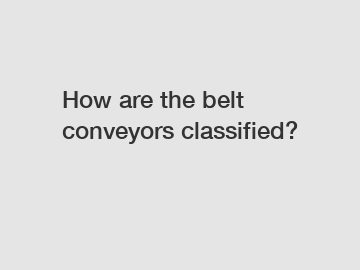Dec. 26, 2023
Machinery
How are Belt Conveyors Classified?
Belt conveyors are essential in various industries for transporting goods and materials efficiently and safely. These machines are designed to move items from one point to another along a continuous loop of rotating belts. To meet the diverse needs of different industries, belt conveyors are classified into several types based on their design, mode of operation, and application. This article explores the various classifications of belt conveyors and their unique characteristics.
1. Flat Belt Conveyors:

Flat belt conveyors are the most common type, consisting of a flat continuous belt supported by rollers or pulleys. These conveyors are suitable for transporting lightweight and small-sized materials. They are commonly used in industries like food processing, packaging, and pharmaceuticals.
2. Troughed Belt Conveyors:
Troughed belt conveyors feature a trough-shaped belt that helps contain the materials being transported. The edges of the belt are raised to prevent the items from falling off during transportation. Troughed belt conveyors are ideal for handling bulk materials, such as grains, coal, and minerals, in mining, agriculture, and construction industries.
3. Cleated Belt Conveyors:
Cleated belt conveyors have raised sections or cleats on the belt, which provide extra grip to prevent materials from sliding backward or falling off. These conveyors are commonly used in steep inclines or when handling loose materials like sand, gravel, or agricultural products.
4. Magnetic Belt Conveyors:
Magnetic belt conveyors use magnets beneath the belt to attract metallic materials. They are often used in industries where magnetic parts or objects need to be moved or separated, such as recycling plants, metalworking, and automotive manufacturing.
5. Inclined Belt Conveyors:
As the name suggests, inclined belt conveyors transport materials at an incline or vertical angle. They are useful for moving materials between different levels or floors within a building or when navigating through limited space. Inclined belt conveyors are commonly seen in airports, warehouses, and distribution centers.
6. Roller Bed Belt Conveyors:
Roller bed belt conveyors feature rollers along the bed of the conveyor, reducing friction and allowing for smoother material transportation. These conveyors are suitable for handling heavy loads and can be found in industries such as mining, construction, and manufacturing.
7. Slider Bed Belt Conveyors:
Slider bed belt conveyors have a flat surface bed with horizontal or trough-shaped slider panes. They are ideal for transporting bulky or irregularly shaped items that could get caught in the gaps between rollers. Slider bed belt conveyors are commonly used in recycling facilities and assembly lines.
In conclusion, belt conveyors play a vital role in streamlining material handling operations in various industries. Their classification into different types allows for a more targeted and efficient transportation solution. Whether it's the lightweight and flat design of flat belt conveyors or the ability of magnetic belt conveyors to handle metallic materials, each type offers unique advantages for specific applications. Understanding the different classifications can help businesses choose the right belt conveyor that best suits their needs and industry requirements.
For more information or assistance in selecting the appropriate belt conveyor for your organization, please do not hesitate to contact us.
Keywords: contact us.
If you are looking for more details, kindly visit Aoyuan Rubber Machine Belt, Aoyuan Rubber Machine Belt, Aoyuan Rubber Machine Belt.
If you are interested in sending in a Guest Blogger Submission,welcome to write for us!
All Comments ( 0 )